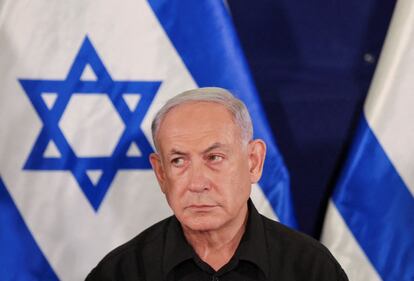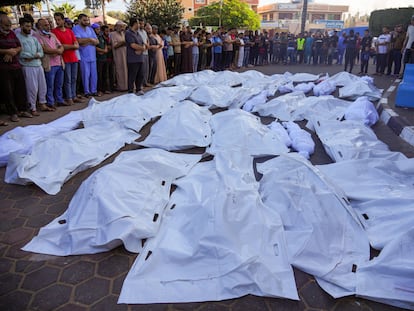Netanyahu assures that Israel will have ‘indefinite’ control over Gaza after the war
The Israeli Minister of Defense declares that the army is already ‘in the heart’ of Gaza City as entire families flee on foot, with white flags and arms raised, from the area most affected by the bombings

When the war is over, Israel will control “overall security” in Gaza for an “indefinite period.” This is what Prime Minister Benjamin Netanyahu said in his first statements on what the Palestinian enclave will be like after the “destruction” of Hamas. Eliminating the militant group is the objective of Israel’s military, which has now arrived in “the heart” of Gaza City, the capital of the Strip, according to Minister of Defense Yoav Gallant. In one month, Israel’s bombing and land invasion have caused more than 10,000 deaths — mostly children and women — and a “displacement and humanitarian tragedy of colossal proportions,” as defined on Tuesday by the U.N. agency for Palestinian refugees, UNRWA.
“I think Israel, for an indefinite period, will have the overall security responsibility because we’ve seen what happens when we don’t have it,” Netanyahu said in an interview with the U.S. network ABC. The phrase leaves the door open to several options. To begin with, he speaks of “overall security responsibility,” which would be compatible with the presence in the Gaza Strip of other troops, such as the multinational force that the United States is considering in talks with its allies.
Even more so when Israel has made it clear that it does not intend to permanently reoccupy, manage day-to-day affairs or re-erect settlements in the enclave. That is, to repeat the regime it maintained between 1967 — when it captured the territory in the Six-Day War — and 2005, the year in which Ariel Sharon’s government unilaterally evacuated all soldiers and settlers from the enclave. Israel considers that, from that moment on, it has no responsibility over Gaza, although under international law it continues to have legal obligations over its civilian population, as it is still an occupying power.
In this context, Netanyahu doubled down on his opposition to a “general ceasefire” without the previous liberation of hostages held by Hamas, since he considers a cessation of hostilities would be giving the militant group room to breathe. He would accept, however, “tactical, little pauses, an hour here, an hour there.” “We’ve had them before... We will check the circumstances in order to enable goods, humanitarian goods to come in, or our hostages, individual hostages, to leave,” he added.
Israeli political and military leaders have been floating the idea that, once the Hamas government and militia are wiped out, Israel’s army should retain the ability to enter Gaza at will for raids, targeted assassinations and arrests. The latest to share this view was Defense Minister Yoav Gallant, who on Tuesday said that the Israeli Defense Forces (IDF) “will retain full freedom to act in any situation in which there is any kind of threat from Gaza.”
Raids in the West Bank
The statements outline a similar picture to the reality of the West Bank. There, 18% of occupied territory — where the main towns are and, therefore, where the majority of the population is located — constitutes the so-called Area A, according to the terminology of the 1993 Oslo Accords. In those areas, the Palestinian National Authority (PNA) forces control security and coordinate with the IDF, but the latter makes incursions when they deem it necessary. Daily, in the last month — following the Hamas attack that killed some 1,400 people — they have made hundreds of arrests and killed more than 130 Palestinians, including by aerial bombardment, as they did during the Second Intifada (2000-2005).
The whole of Gaza is technically Area A, except that the PNA has not carried out its role there since 2007, when Hamas prevailed in a week of street clashes with Fatah (the rival faction led by Abbas), a year after winning the elections.

Netanyahu cryptically asserted that the Gaza government will be left in the hands of “those who don’t want to continue the way of Hamas,” without clarifying whether he was referring to the PNA. Last Sunday, its president, Mahmoud Abbas, said he was open to that possibility, provided that it was accompanied by a peace agreement on the horizon involving the creation of a Palestinian state. “We will fully assume our responsibilities within the framework of a comprehensive political solution that includes the entire West Bank, including East Jerusalem, and the Gaza Strip,” he said, according to the official Palestinian news agency Wafa.
Long distances on foot
Meanwhile, the bombardments do not let up: neither in the north, nor in the south of Gaza, the area to which Israel has ordered the population to move to and the only one to which humanitarian aid is entering from Egypt. “There is no turning back, no rest. We are only moving forward,” Defense Minister Gallant said at a press conference in Tel Aviv. A message that Netanyahu elaborated on shortly after, in a speech to the nation. “In Gaza we are advancing with a force that Hamas did not know [...] Gaza City is surrounded. We operate inside it and increase the pressure on Hamas. We have eliminated thousands of terrorists, above and below ground,” he said, referring to the network of tunnels used by the militia. The army has also released images of soldiers in Gaza. One of them shows a Ferris wheel just south of the capital.
An estimated 300,000 Gazans remain in the north, the area hardest hit by the bombing that is reducing Gaza to rubble. Netanyahu sent them a message on Tuesday: “Keep going south [of the Strip] because we are not going to stop.” And another to Hezbollah, the Lebanese militia with which skirmishes have intensified in recent days: “If you decide to go to war, you will make the mistake of your life.”
The roads leading to Salah al-Din, the highway that runs vertically through Gaza, are so damaged that entire families (with children, elderly and disabled people) are forced to walk long distances carrying their belongings, as highlighted in the latest report by the U.N. Office for Humanitarian Affairs (OCHA) and as shown in images and videos coming from inside Gaza. Hundreds of Palestinians could be seen walking together on Tuesday, some with white flags and their hands in the air. OCHA estimates that another 5,000 people headed south on Monday, during the six hours during which Israel opened a “humanitarian corridor” that few dare to take because airstrikes has been reported along the way and because the Israeli army is active in both halves of the Strip. On Sunday, some 2,000 made the journey south. The Israeli army claims that Hamas is preventing the population from escaping.
According to United Nations data, almost 45% of the buildings in Gaza have been affected by these unprecedented attacks: more than 40,000 have been directly destroyed or rendered uninhabitable, and another 220,000 have been damaged to a greater or lesser extent. Aerial images show the destruction of entire neighborhoods; and others, recorded from vehicles or on foot, show rows of collapsed buildings or that have lost their exterior walls.
The Palestinian militia captured more than 240 people in their attack on Oct. 7. According to Abu Obeida, the spokesman for Hamas’ armed wing, the Izz ad-Din al-Qassam Brigades, which is holding most of them, the intense and constant Israeli bombardment has already killed more than 60 hostages. Netanyahu, under increasing pressure from the street to bring about their return, stressed Tuesday that the “military operation is part of the effort to bring the hostages home.”
Sign up for our weekly newsletter to get more English-language news coverage from EL PAÍS USA Edition
Tu suscripción se está usando en otro dispositivo
¿Quieres añadir otro usuario a tu suscripción?
Si continúas leyendo en este dispositivo, no se podrá leer en el otro.
FlechaTu suscripción se está usando en otro dispositivo y solo puedes acceder a EL PAÍS desde un dispositivo a la vez.
Si quieres compartir tu cuenta, cambia tu suscripción a la modalidad Premium, así podrás añadir otro usuario. Cada uno accederá con su propia cuenta de email, lo que os permitirá personalizar vuestra experiencia en EL PAÍS.
¿Tienes una suscripción de empresa? Accede aquí para contratar más cuentas.
En el caso de no saber quién está usando tu cuenta, te recomendamos cambiar tu contraseña aquí.
Si decides continuar compartiendo tu cuenta, este mensaje se mostrará en tu dispositivo y en el de la otra persona que está usando tu cuenta de forma indefinida, afectando a tu experiencia de lectura. Puedes consultar aquí los términos y condiciones de la suscripción digital.
More information
Archived In
Últimas noticias
Sydney Sweeney, the actress praised by Trump: ‘Women are up against what society wants them to be’
The Bolsonaro surname: An advantage or liability in Brazil’s 2026 presidential elections?
Raúl Rocha, from jet-setting with Miss Universe to arms trafficking and fuel theft
80,000 barrels of Mexican oil sent to Cuba: Havana drawn into the US–Mexico clash
Most viewed
- Reinhard Genzel, Nobel laureate in physics: ‘One-minute videos will never give you the truth’
- Pablo Escobar’s hippos: A serious environmental problem, 40 years on
- Charles Dubouloz, mountaineering star, retires at 36 with a farewell tour inspired by Walter Bonatti
- Why we lost the habit of sleeping in two segments and how that changed our sense of time
- The fall of a prolific science journal exposes the billion-dollar profits of scientific publishing











































